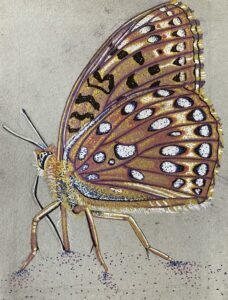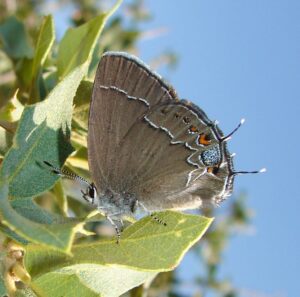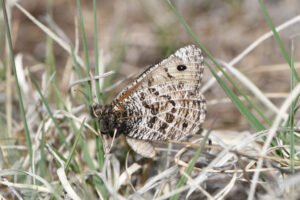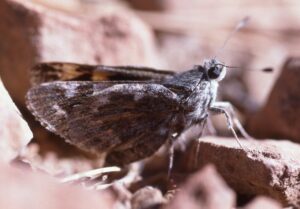By Simon Doneski, graduate student in invertebrate ecology and conservation at the University of New Mexico

In 1972, mathematician and meteorologist Edward Lorenz first coined the term “butterfly effect,” stating that “whatever we do affects everything and everyone else, if even in the tiniest way.” He famously claimed that “when a butterfly flaps its wings, a breeze goes around the world.” There are few better places to appreciate this interconnectedness and complexity than in nature.
Years before Lorenz used the term, Aldo Leopold had intuited the butterfly effect in the context of the natural world. In “A Sand County Almanac,” Leopold states that “the first step of intelligent tinkering is to keep all the parts,” suggesting that all species should be protected, as they may be essential parts of an ecosystem in ways beyond current understanding. Anthropogenic manipulation has ripple effects often surpassing what we can foresee.
Unfortunately, we have already lost essential parts of natural systems before ever understanding their importance, sometimes before even knowing of their existence. The pace of these losses only continues to accelerate. One such loss is in the declining population and diversity of butterflies.

One of my first experiences of the butterfly effect came in childhood, though not through mathematics or meteorology. It came to life for me during countless afternoons spent chasing butterflies in the fields near my home in New Hampshire. I remember vividly the first time I spotted a painted lady, its orange and black wings glowing in the sunlight. I was mesmerized by its fragile beauty and the way it seemed to embody freedom and connection to the natural world. At the time, I didn’t realize that these small moments would spark a lifelong fascination and eventually guide my career. I have since dedicated my work to protecting rare and endangered butterflies across the United States. This journey started close to home, on a project protecting the endangered Karner blue butterfly and ultimately brought me to the University of New Mexico where I have spent the past six years.
New Mexico is an excellent place to study butterflies, with some of the highest diversity in the country and many endemic subspecies. Despite this, butterflies are vastly under-protected in our state. New Mexico’s Department of Game and Fish does not currently have regulatory authority over invertebrates; they are not included in the state’s definition of “wildlife.”* As a result, all insects—butterflies included—are left vulnerable in a world rife with human-made threats.
Last summer, our team spent countless hours searching through the beautiful meadows and forests of the Carson National Forest in

Northern New Mexico looking for the Front Range variable checkerspot (Euphydryas anicia capella). Despite intensive efforts, not a single individual was found, and we couldn’t help but notice overall fewer wings fluttering and colors dancing in the air than in years past. The absence of life was heart-wrenching and a stark reminder of how quickly losses can happen.
Dangers to butterflies and other arthropods include pesticide use, fire suppression, anthropogenic climate change and habitat loss. These threats are driving butterfly declines which are expected to continue and worsen. Experts estimate that the Western U.S. is likely to lose a third of butterfly species in the next 25 years. In 2023, New Mexico recognized its first protected insect with the listing of the Sacramento Mountains checkerspot butterfly as endangered by the U.S. Fish and Wildlife Service. A year later, the Nokomis silverspot joined the checkerspot on the endangered species list. That same year, the New Mexico Department of Game and Fish identified 37 butterflies as Species of Greatest Conservation Need (SGCN) for the first time. Many of these butterflies face a bleak future unless conservation efforts can be swiftly implemented.

Insects provide essential ecosystem services: 35% of the world’s food supply is insect-pollinated, along with 75% of all flowering plants. Each species has its own particular role in its ecosystem and unique relationships with the organisms around it. This makes them essential parts of our ecosystems in ways that, as Leopold suggested, we probably still don’t understand. Additionally, the ecosystem services provided by insects not only uphold our native ecosystems but add an estimated $57 billion dollars a year to the U.S. economy.
Effective conservation relies on accurate identification of species at risk of extinction. My research focuses on trying to identify threatened butterflies and connect them with the conservation efforts they need to survive, before it’s too late. This entails detailed conservation assessments, population monitoring and careful examination of the natural history of populations. Through this work, we have identified many threatened butterflies in our state. I and others at the University of New Mexico partnered with the New Mexico BioPark Society, Natural Heritage New Mexico and the Carrol Petrie Foundation to track some of the state’s most critically endangered insects. The New Mexico Rare Arthropods Resource at nmrare.org contains detailed information on the life history, ecology and threats to many of New Mexico’s rare, endangered and endemic insects, along with recommended conservation actions.
My search for rare butterflies in New Mexico has led all over the state, and I have witnessed disastrous loss firsthand. However, there is one kind of place I can seemingly rely on to find abundant butterflies: wilderness areas. Hiking through the Wheeler Peak Wilderness just this past August, I was greeted by a kaleidoscope of butterflies, their wings catching the morning light as they flitted among the wildflowers. It felt like stepping into a different world, one untouched by the threats that loom outside wilderness boundaries.

Wildernesses are safe havens from industry and development: some of the last places insects can avoid pesticides, habitat loss, mechanization and other threats. They are essential refugia for New Mexico’s wildlife, from charismatic large vertebrates to the often-forgotten arthropods. As a result, wilderness areas often support rich butterfly diversity. Of the 37 SGCN butterflies in New Mexico, 23 reside in designated wilderness.
These areas provide a glimpse into a natural world relatively undisturbed and provide opportunities to study ecosystems with most of the pieces still intact. As we continue to discover how connected the world is, protecting wilderness areas is more critical than ever, not only because they are essential for stopping habitat loss, fighting climate change and protecting species, but also because they protect the small but vital parts of ecosystems that we may not even know exist. Butterflies are an excellent example of this. Before 2023, not a single butterfly was protected in our state, and, without wilderness, we might have lost many before we had the chance to recognize their importance.
Every time I see a butterfly take flight, I am reminded of why this work matters. It is about preserving a world where such beauty and interconnectedness can thrive. Without protected lands, an important piece of the heart and soul of New Mexico would be lost. The consequences of losing these areas would be massive and far reaching ecologically, economically and socially in ways we can’t possibly understand. On the flipside, more protected lands would surely mean a lot more butterfly wings flapping in New Mexico, and who can tell the butterfly effects of that?
(*Editors Note: At the time of publication, New Mexico Wild and our partners are working to pass SB5 in the New Mexico State Legislature, which would enable the NM Department of Game and Fish to assist in butterfly recovery efforts, among other reform and modernization provisions.)

